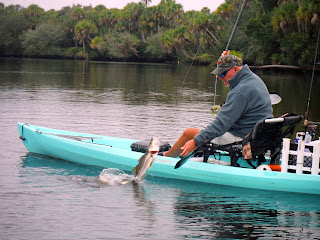 |
| The wind didn't prevent large spotted seatrout from taking a fly. |
It was windy today.
Real windy.
 |
| Spotted seatrout are among salt water's prettiest fish. |
So windy I was the only moron out fishing.
Most had sense enough to stay out of the wind.
To make things even worse, I was fly fishing. I took two fly
rods out with me. I left the spinning gear at home.
Didn't make much sense since the wind was blowing out of the
southeast at 22 miles per hour, with
gusts to 30.
But I launched my NuCanoe Pursuit and paddled almost
directly into a stiff headwind. It took me a little longer than usual to reach
my destination. Once there, I lowered the anchor, pulled it back to the stern
and let the wind turn my kayak to the preferred direction.
First stop resulted in only one small ladyfish.
 |
| The Clouser Deep Minnow accounted for all fish. |
I contemplated just calling it day, but decided to try one
last spot before heading in. I paddled 100 yards south and anchored.
This time, I found spotted seatrout. I caught six in short
order, and all were either in the slot (15 to 20 inches) or over. Largest trout
of the outing was a plump 23-incher.
Not bad in such windy conditions.
I also added a small sugar trout before giving in to the
conditions.
When it's windy, I find anchoring is the only way to go. You
simply cannot present a fly and work it properly when you're on a wind-blown
drift.
With my anchor trolley system, I can always face the desired
direction simply by positioning my anchor properly.
It was tough working the fly even when anchored. The current
was strong, and I was having to "mend" the line uptide in order to
create a decent drift. That allowed me to work the fly slowly.
For this outing, I was using a 7-weight TFO TICRX fly rod
with a sinktip line. Fly of choice was a chartreuse-and-white Clouser Deep
Minnow, perhaps the best fly ever created for saltwater trout.
I landed six trout, but I'll bet I missed another half
dozen. Plus, I had trout get off halfway back to the kayak.
Considering the conditions, I was quite pleased.
Quality ruled out over quantity on a day that simply was two
windy except for mad dogs and me.







